
Journal of Contemporary Urban Affairs
2021, Volume 5, Number 1, pages 47– 58
Model Cities for Resilience: Climate-led Initiatives
* Dr. Didem Gunes Yilmaz 
Department of Architecture, Faculty of Architecture and Design, Bursa Technical University, Bursa, Yıldırım Kampüsü, 152 Evler Mah., Eğitim Cd. No:85, Turkey
Email: didem.yilmaz@btu.edu.tr
ARTICLE INFO:
Received 18 February 2020
Accepted 20 July 2020
Available online 25 July 2020
Keywords:
Climate Change;
Sustainable Cities;
Sponge Cities;
Cities and Natural Disasters;
Cities and Climate Actions.
ABSTRACT 
Paris Agreement of December 2015 was the last official initiative led by the United Nations (UN) as the driver of climate change mitigation. Climate change was hence linked with an increase in the occurrence of natural hazards. A variety of initiatives were consequently adopted under different themes such as sustainable cities, climate-friendly development, and low-carbon cities. However, most of the initiatives targeted by global cities with urban areas being the focus in terms of taking action against global warming issues. This is due to the structural and environmental features of cities characterized by being populated, as such, they not only generate a large number of carbon emissions but also happens to be the biggest consumer of natural resources. In turn, they create a microclimate, which contributes to climate change. Masdar City, for example, was designed as the first fully sustainable urban area, which replaced fuel-based energy with electric-based energy. China, as another example, introduced the Sponge Cities action, a method of urban water management to mitigate against flooding. Consequently, architects and urban planners are urged to conform to the proposals that would mitigate global warming. This paper, as a result, examines some of the models that have been internationally adopted and thereafter provide recommendations that can be implemented in large urban areas in Turkey, primarily in Istanbul.
JOURNAL OF CONTEMPORARY URBAN AFFAIRS (2021), 5(1), 47-58.
https://doi.org/10.25034/ijcua.2021.v5n1-4
www.ijcua.com
Copyright © 2020 by Didem Gunes Yilmaz.
1 . Introduction
Human beings experience different types of natural disasters during their lifetimes. Some types of natural disasters strike certain locations because of seasonal and natural deeds. For example, in the Atlantic Basin from the beginning of June to the end of November, there is a high possibility of a tropical cyclone strike, which is called a hurricane. The most prone areas, therefore, are the Atlantic coast and the Gulf of the United States, and the islands of the Caribbean. The season of cyclones in the South Pacific and the Indian Ocean is between November and April. Tropical cyclones striking the Northwest Pacific Ocean are called Typhoon and threaten the islands of Japan and the Philippines. Differently, the west coast of the United States is prone to earthquakes and wildfires rather than hurricanes. Countries including Turkey, Iran, Greece, and Italy are known as earthquake-prone countries because of their geological seismic structures. India, Bangladesh, Indonesia, and Thailand are countries exposed to river floods very often due to heavy rainfalls and their low-lying lands. These examples are to frame the natural reasons for some hazard types. Accordingly, natural disasters can be categorized into five groups: geophysical, biological, meteorological, hydrological, and climatological (Figure 1). Some types of hazards turn into disasters for a small area and a short period, such as earthquakes and volcanic eruptions. Some of the hazards under the categories of meteorological, hydrological, and climatological affect larger areas and most of the time last for a long period varying from days to years. Consequently, natural disasters are categorized based on their speed of happening as well. Droughts, changes in the amount of rainfall and the rise of sea level are among the slow-onset disasters that “that does not emerge from a single, distinct event but one that emerges gradually over time, often based on a confluence of different events” (Adamo, 2011). Slow-onset disasters are considered likely to have resulted in population displacement and migration mobility due to environmental challenges. Hence, they have social and economic effects in the long run since the movement becomes either temporary (that is, seasonal) or permanent in the case of the environmental conditions that cannot be restored. Rapid-onset disasters, on the other hand, have an instant impact, although some allow for the early warning system. Earthquakes, for instance, cause severe destruction in the built environment in only a few seconds, and sometimes they trigger further disasters such as tsunamis, landslides, fires, and explosions (for example Fukushima Nuclear leakage in 2011). Nonetheless, they are considered rapid-onset disasters that require urgent intervention and preparation can simply improve the coping with strategies in most cases. Some geophysical disasters can cause hydrological disasters too. For example, a volcanic eruption emits a great amount of sulphur dioxide that the reaction in the atmosphere creates acid rains afterward (for example Kilauea eruption in 2018). However, not all geophysical disasters are bound to a hydrological, meteorological, or climatological disaster. The latter three can occur alone resulting from a serial formation of natural events. According to the EM-DAT Database in 2020 (Table 1), the total number of natural disasters reported around the world significantly increased between 1970 and 2019.
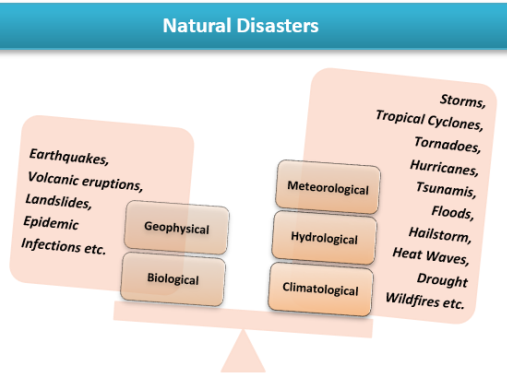
Figure 1. Types of natural disasters and their effect size.
Floods and extreme weather events have the largest shares among the others (including earthquakes, and landslides) and have witnessed a remarkable increase from the year 2000 and onwards. Extreme weather events, mostly refer to heat waves and hailstorms, where floods occur mainly due to extreme precipitation, coastal storms, and sea-level rise. Generally, the upsurge in the numbers of disasters reported can be explained by the fact that technology and communication have made it easier to undertake monitoring unlike before. However, the rise of the frequencies in the occurrence of floods and extreme weather events cannot be simply explained by this fact since other types of disasters (such as earthquakes and landslides) do not follow such an increasing frequency. This draws attention to climate change where research from the USA showed that since 1950, extreme precipitation events increased in 193 out of 244 cities across the country, particularly in the Southeast lands. This is explained by the fact that as global warming causes more evaporation from water resources (such as oceans and lakes), it results in the atmosphere containing 4% more water molecules than the usual average (Climate Central, 2019). The debate intensified after the 1990s, although the issue is mostly rooted back to the 19th century during the first industrial revolution. As such, it took decades to convince world populations and the respective governments that the concern was real since some events were accompanied by evidence.
Today, global temperature rise, warming oceans, shrinking ice sheets, glacial retreat, decreased snow cover, sea-level rise, declining arctic sea ice, extreme events and ocean acidification are deemed evidence of climate change by the National Aeronautics and Space Administration. Hence, climate change is a collective term and global warming is a large part of it. IPCC, as a result, reported that the global surface temperature will rise by between 1 to 3.5 Celsius degree by the year 2100. However, it was only between 2006 and 2015, when it increased by 0.87 Celsius degree. At this point, the Paris Agreement was introduced in December 2015 to campaign against global warming by keeping the rise of the global surface temperature below 2 Celsius degrees by the end of the current century. This goal is strongly linked with the prevention of greenhouse gas (GHG) emissions into the atmosphere, which mainly refers to carbon dioxide and methane gases. An early study by Tyndall in 1859 discovered that carbon dioxide significantly absorbs solar radiation (Hulme, 2009). Consequently, its accumulation in the atmosphere is responsible for global warming. Table 1 presents a summary of the natural disasters reported on the global scale between 1970 and 2019.
Table 1. Natural disasters were reported on a global scale between 1970 and 2019.
|
Year
|
Floods
|
Extreme weather
|
Drought
|
Earthquake
|
Landslide
|
|
1970
|
31
|
24
|
2
|
11
|
5
|
|
1975
|
17
|
28
|
-
|
4
|
5
|
|
1980
|
39
|
42
|
14
|
24
|
4
|
|
1985
|
58
|
51
|
3
|
22
|
6
|
|
1990
|
60
|
137
|
12
|
43
|
4
|
|
1995
|
94
|
81
|
6
|
26
|
16
|
|
2000
|
157
|
102
|
27
|
30
|
28
|
|
2005
|
193
|
130
|
20
|
25
|
13
|
|
2010
|
184
|
94
|
17
|
24
|
32
|
|
2015
|
160
|
118
|
28
|
23
|
20
|
|
2019
|
170
|
85
|
15
|
32
|
22
|
Source: Adapted with modifications from the EMDAT 2020 Database.
Because of the relationship between GHG emission, global warming and climate change (Figure 2), most of the environmental initiatives target the reduction of carbon dioxide emission as much as possible. The built environment makes a great contribution to the total GHG emissions worldwide. According to ISOCARP (2018), “cities occupy only 2% of the world’s land surface, consume 75% of natural resources, produce 50% of global waste and account for 60-80% of GHG emissions”. In more detail, IPCC (2014) reported that buildings’ share in the total global final energy use accounted for 32 % and 19 % of energy-related GHG emissions (Lucon et al., 2015). The report also revealed that energy consumption is largely used for space heating both in residential and commercial buildings. This is followed by cooking in residential buildings and electricity use for powering equipment in commercial buildings (Figure 3). On a larger scale, urban areas’ consumption of global final energy use ranges between 71% to 76% (Seto et al., 2014).

Figure 2. The interrelation between GHG emission, global warming, and climate change.
Needless to mention that the share must have risen in the past decade on the account of the number of building stock that increased towards the end of the year 2020. Urban built environment is therefore seen as a key driver in combatting climate change. IPCC, therefore, notes that adopting new technological options, changing design practices, and behavioural changes can lead to large reductions in building energy consumption. In this case, if it is a new building, such an initiative can result in an energy saving of up to 90%, and if it is a building with alterations, it can save up to 75% of its total energy consumption. Architects and urban planners should, therefore, use adopt a different paradigm that takes cognizance of the environmental impacts during the design to the construction process, and the potential contribution in energy consumption and GHG emission. The current plans and designs of buildings should, therefore, take into account the measures that would eliminate the anticipated environmental impacts. Figure 3 shows the shares in the final energy consumption in residential and commercial use.
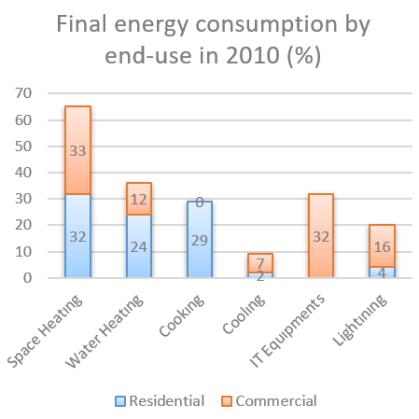
Figure 3. The chart shows the shares in the final energy consumption in residential and commercial use.
Source: Adapted with modifications from IPCC (2014)
2 . Materials and Methods
The generic design discourse has been updated since climate change has become a central focus in the built environment. A go-green revolution is, therefore, being promoted for cities(Grey, 2018). Accordingly, new radical cities are built, or existing ones undergo radical changes. For example, Low Carbon Liveable Cities Initiatives by the World Bank (2009) support the model of low-carbon cities in developing countries. Besides, eco-cities, zero carbon, or carbon-neutral cities are models being developed as a strategy for promoting the concept of a sustainable city.
This paper, therefore, reviews case studies of various ‘new’ urban approaches. The examples include the Masdar City project in Abu Dhabi, Sponge Cities interventions in Chinese cities, and further examples from different countries that aim to be carbon-neutral, self-energy sufficient and ecological cities ideally. The paper also highlights key features in the design of the projects and thereafter examines a list of strategies commonly adopted. The current study further reviews the cases from the qualitative approach, which focuses on the outstanding design features and their expected environmental benefit on residents. A conclusion is finally made on the most appropriate design.
3 . Ideal Cities vs. Energy Consumption
3.1 Masdar City
In 2006, Abu Dhabi’s authorities were motivated by the green energy concept and had the vision to prepare the Emirate for a possible post-oil energy era. Masdar City was planned to be a zero-carbon eco-city, which aimed to keep the amount of carbon emission at zero. To achieve this, the city adopted the vernacular Arabic architecture and utilized all the required cutting-edge technology through solar power panels to produce energy in sustaining the complex (Günel, 2019).
The City was planned to host 40 thousand people and 50 thousand commuters daily with the entire project was planned to be completed by the year 2016. Unlikely, in 2015 the population of the City was still only composed of graduates and students at the Masdar Institute and some employees that were less than two thousand (Lee, Braithwaite, Leach, & Rogers, 2016). However, the completion date of the project was delayed until 2030 due to the various crises and challenging conditions that affected the project. During the process, the project evolved, and the goal did not remain the same. Masdar City still plans to be a low-carbon city. In this context, the energy sources of the City were diversified into photovoltaic panels (53%), concentrated solar power (26%), evacuated thermal cube collector (14%), and waste reuse (7%) to provide it fully self-sustained (Afkhamiaghda, 2015). At the same time, more than 22-hectares-of-land are fully occupied with solar panels which generate power to the City, needless to say, that local dust storms occasionally block the area. Apart from the benefits of the traditional Arabic city layout, which provides shade during the day over the streets and prevents overheating, the City was also built on a raised ground for 7-8 meters to maximize its exposure to the cooling winds and decrease the need for air conditioning. Waste management was as well significant for the project since the target was zero-waste. The waste was categorized under the categories of compostable bio-waste, non-recyclable, and recyclable (Manghnani & Bajaj, 2014). 96% of construction waste was either reused or recycled (Mezher, Dawelbait, & Tsai, 2016). In buildings, while energy consumption is 56%, that of clean water consumption is 54%, less than any other conventional building. Inflatable ETFE cushions were used on the Laboratory building facades to barrier the heat transfer from outside and the Arabic latticework was applied on the concrete facades to provide shade to the interiors (Patel & Griffiths, 2013).
Besides, all the buildings in the City must meet a minimum 3-Pearl rating according to the Estidama Pearl Building Rating System, which is Administered by the Abu Dhabi Department of Municipalities and Transport (3-Pearl Estidama rating is comparable to the LEED Gold international green building certification). Nevertheless, it remains arguable whether the Masdar City project was promoted to the extent that it seemed unrealistic or a failure to some. Nevertheless, by 2019, only 10% of the entire project had been completed. Although it was planned to be a car-free city by replacing fuel-based transportation system with driverless Personal Rapid Transit (PRT) system (Figure 4), today electric vehicles and shuttles actively on the City roads of (Patel & Griffiths, 2013). From the humanistic perspective, it has been observed that the process was purposefully government-controlled instead of taking the concerns and desires of the local community (Lau, 2012).
Buletti and des Noisetiers (2011) argued that the architecture of the city and the use of high-tech applications (for example facades and large roof decorated with solar panels) was to draw an attractive image for scientific community members, and the very polished renders were to attract the luxury-interested society members so that it creates its own selected gated community under an eco-city roof. Similarly, Cugurullo (2013) argued that the City was planned from a business aspect (mainly technology-based funds flow) leaving the social aspects behind. A study by Kherdeen (2016) also maintained that the timeline allowed for the project was too unrealistic that made it impossible for its objective to be attained owing to the lack of research in its development phase. Figure 4 shows the conception section of the Masdar HQ, the biggest office building in the City, and the distance by walk to LRT (light rail transport) and PRT.


Figure 4. The conception section of the Masdar HQ, the biggest office building in the City and the distance by walk to LRT (light rail transport) and PRT (personal rail transport).
3.2 Chinese Eco-Cities
As the country that has the largest population, China makes attempts to solve the problems of urban settlements. In the past decades, the Chinese government channeled its economic resources into building sustainable cities, and eco-cities projects. By the year 2015, more than a hundred cities were planned to be transformed into eco-cities and more than 250 to be eco-city or low-carbon city (Caprotti, Springer, & Harmer, 2015). Dongtan eco-city and Tianjin eco-city are the two examples that are highly discussed in the literature. Tianjin eco-city (Figure 5) is deemed the “flagship national eco-city Project” on the east coast of China. The project was jointly developed by the Chinese and Singaporean governments (Caprotti et al., 2015). The idea of the project was initiated in 2007, and by the end of 2008, the Master Plan of the City had been finalized. The City planned to be home to 350 thousand residents and also provide job opportunities for 190 thousand by 2020. The energy sources were diversified to include solar, geothermal, and wind. Like in Masdar City, a solar panel site was built outside the Tianjin eco-city to power the offices. Wind turbines were mounted to supplement the solar panels. Additionally, geothermal energy was introduced and used to power the administration building with 50 pumps. The electricity and the pumps were powered by the energy produced by the solar panels.
The waste management problem in bathrooms was solved with the use of ecological taps and toilet flushes that ensured minimum waste. Large lawn areas and porous ground allowed for the reuse of rainwater. For the cleanliness of the urban environment, the pneumatic rubbish collection system was configured. However, because the system was found complicated at first by the residents, they disliked it(Li, Bonhomme, & Deroubaix, 2018). The City’s layout was planned with a walking distance of 400 meters to enable the residents to easily access public amenities, clinics, markets, kindergarten, and primary school. In this way, energy consumption based on transportation needs was diminished in the inner city (Yao & Chong, 2010). The public transportation network was established with light rails, hybrid and electric bus systems. For the residential building stock, high-rise buildings that had 20 to 30 stores were preferred. The land selected for the project development was mainly grey and brownfield areas (Chang, 2017).
Since Tianjin a city facing water scarcity, the Tianjin Municipality Ecological City Development has adopted local codes and regulations to force water conservation, water-saving technologies in seawater desalination, wastewater treatment, water reuse, and flood and storm management (World Bank, 2009) While Tianjin eco-city was realised, the development of Dongtan eco-city was, on the other hand, was postponed until. ARUP was consequently hired in 2005 to design and construct the project. It was aimed to have 60% less ecological footprint, 60% less energy consumption and to emit almost no carbon dioxide while producing 40% of the total energy required. The City was planned to have three villages to host 500 thousand people. In Dongtan, all vehicles in transportation would run on batteries or hydrogen fuel cells. An alluvial island was chosen for the development which was home to the migratory water birds. For the residential blocks, low-rise buildings (four to eight stories) were preferred, unlike Tianjin. Chang (2017) argued that the lessons learned from the failed dream of the Dongtan eco-city gave birth to a rather successful example, Tianjin. However, Caprotti et al. (2015) criticized that the project of Tianjin was a design with high reference to countries of Singapore and Taipei, fashioning the eco-city and thus, to attract people from a wealthy background. Figure 5 illustrates the view of Tianjin from the riverside.
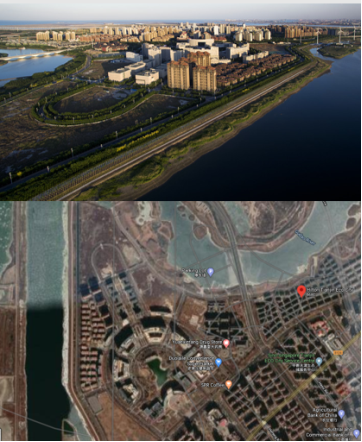
Figure 5. The view of Tianjin from the riverside and the location map (Source: Google Maps).
3.3 Chinese Sponge Cities
Urban water management includes rainwater, groundwater, wastewater, and clean water management. The concept of Sponge Cities mainly focuses on water management regarding the control of rainwater, groundwater, and riverbeds. It is about preventing water-related disasters such as floods due to heavy rainfalls. The “sponge” defines the process of absorbing water and control it through and release it when necessary. China launched the program in late 2014, to reuse 70% of rainwater. While by 2020, the goal was to achieve this in 20% of the cities, further, by 2030, the goal is to reach 80% of the cities across the country (Huang, Shen, & Mardin, 2019). Therefore, the project targets the urban areas, primarily under the risk of flooding. It first begins with harvesting the rainwater at the building scale. Roads and office buildings collect, purify, and reuse rainwaters. The goal is to decrease the pressure on the drainage system. Hence, the difference between eco-city and sponge city is that eco-city focuses on the energy consumption in all kinds, whereas sponge city focuses on the rainwater management to prevent possible flooding of the human settlements in cities. In 2015, 16 pilot cities were selected for implementation, including Wuhan, Chongqing, and Xiamen, and in 2016 another 14 cities were added to the list, including Beijing, Tianjin, Shanghai, and Shenzhen (Zevenbergen, Fu, & Pathirana, 2018). For example, Yanweizhou Park in Jinhua City, Zhejiang Province of China (Figure 6), is one of the examples designed by Dr. Yu Kongjian, founder and Principal Designer of Turenscape and Dean of the College of Architecture and Landscape Architecture at Peking University. To build a resilient park, the bridge was elevated above the ground-based on a 200-year flood level and approaching to 700 m long, the bridge provides a connection of the island with no blockage during the wet season as well (Toh, 2018).

Figure 6. The view of Yanweizhou Park during the dry season on the left, wet season on the right. Source: (Toh, 2018).
To give another example, Yangtze Riverfront Park in Wuhan was completed in 2018. Wuhan had the worst rainfall events of its past 18 years from 2016. Since the river was the main reason for flooding, to achieve a resilient urban area, 7 km long Beach Park fully covered with vegetation was designed as a buffer zone between the buildings and the riverside. Because the river culture was very common in Wuhan, the Park created was designed as a promenade that the public would enjoy walking and skating.
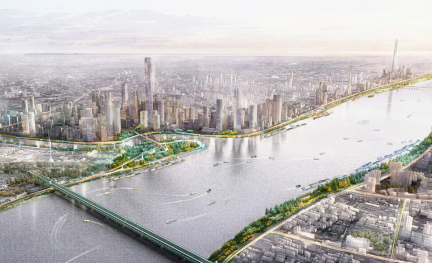
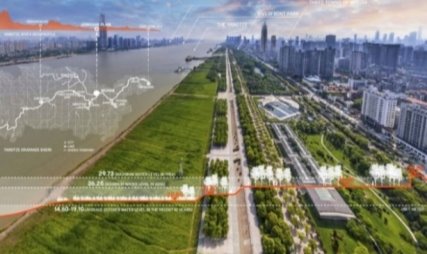
Figure 7. The Riverside renders for both sides and the closer rendering of the area.
Source: Sasaki Associates (2020)
3.4 Low-Carbon Society and City
Japan started the move ‘Low-Carbon Society’ in 2013, and since then made ‘City-to-City’ collaborations with other Asian countries to exchange know-how technologies and to lead the process overseas. Today, there are 25 cities in Cambodia, India, Indonesia, Laos, Malaysia, Mongolia, Myanmar, Philippines, Thailand, and Viet Nam, which are co-operating with 12 Municipalities in Japan, including Hokkaido, Sapporo, Toyama, Fukushima, Kyoto, Kobe, Osaka, Kanagawa, Kawasaki, Yokohama, Tokyo, and Kitakyushu.
The cities in Japan are urged to take action according to the Act on Promotion of Global Warming Countermeasures. Japan’s target is to reduce carbon emission by 26% by 2030, and 80% by 2050.
Yokohama city aims not only to reduce carbon emission but also to transform the city into a smart city. Yokohama was selected in 2010 as the lead in Smart City Project, and after 2015 the city began to apply the measures, which target energy efficiency in the transportation network, improved disaster prevention capabilities, better environmental performance, and at last gain economic efficiency as well (Akagi, 2018). Based on the data from 2017, the energy industry contributes to carbon emission by 22%, commercial buildings by 21% and residential buildings by 22%. Transportation system contributes by 19% and various industry contribution is 11% (Akagi, 2018). Accordingly, the City aims to reduce GHG emission amount by 30% per person by 2025, and by 2050 the goal is to reach 60%. Regarding the built environment, the new buildings must meet the energy conservation standards, and to build greenhouses, low-interest loans are made available (UNESCAP, 2012). According to C40 International Initiative, the transportation network was planned to be adjusted based on non-fuel vehicles. The City provided two thousand electric vehicles and provided charging stations as well. Besides, across the borders of Yokohama city, solar power generation in 249 locations, wind power generation in 2 locations, hydropower generation in 3 locations, and biomass power generation in 6 locations will be implemented (C40 Cities, 2014). Nonetheless, the municipality was also aware of the fact that without informing the residents, the achievement cannot be realized. Hence, within a school project, 418 lectures were held for 35,000 participants to sensitize them about the change the city was about to experience.
4. Turkey and the Case of Istanbul
Turkey is the 20th largest GHG emitter in the world (Timperley, 2018). The main natural resource used for energy production is coal. There are 15 thermal plants across the country producing electricity power by consuming the coal reserves (Kiliç, 2006). However, as a developing country, Turkey imports other kinds of sources as well, including natural gas and oil, given that the country neighbors Iran, and close to Azerbaijan, Russia, as also the leading fossil energy exporter countries in the world. Other than coal, hydro dams are also electric energy providers of the country. Although the country could benefit from solar and wind energy, it does not have large energy plants. Differently, a nuclear plant is under construction in Akkuyu, Mersin, the south coast, since 2017 and is planned to start operation in 2023. A second plant is under bureaucratic progress for Sinop, the Black Sea coast. The third one in İğneada, the northwest coast, is still under design. In 2010, Turkey published a targeted to increase the production of electricity from renewable resources by 30% in 2023. Regarding transportation, the aim is to upscale renewable energy by at least 10% by 2023 (Timperley, 2018).
Turkey is an earthquake-prone country due to geophysical conditions. However, in the past decades, the country also began experiencing severe floods and landslides in the cities, due to climatological changes. Istanbul, as the largest metropolitan city in the country, experienced more often than before such disasters after heavy rainfalls. The floods are the result of the combination of the increased water flow in the Bosphorus and the insufficient underground stormwater drainage systems in the city (Figure 8). The densely built environment also prevents the flow of rainwater through the underground owing to the absence of green areas (Turoğlu, 2011). Although the city has experienced several flood events, the most memorable one was in September 2009. In this case, the Ayamama River basin overflowed, and the flood-affected a large area, including the motorway as well as the settlements. The flood caused the death of 31 people (Reyes-Acevedo, Flacke, & Brussel, 2011).
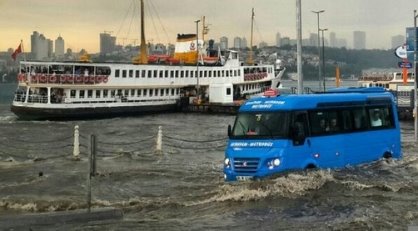
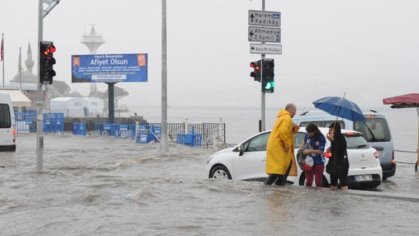
Figure 8. The floods cause to the scenes that the citizens were neither familiar with nor prepared before (Istanbul).
5. Discussion and Conclusions
Sustainable projects are long-term projections, consequently, they require huge investments because they involve multiple stakeholders who invest and take an active role during their operation (Zhan, De Jong, & De Bruijn, 2018) The local authorities should hence recognise this fact. From the cited examples, it is now more apparent that the built environment forms a key determinant in climate change through carbon emission. As already observed, the first goal is to reduce this outcome. For that reason, the measures taken as a start should be to adopt an electricity-powered system in favour of fossil-based energy heating resources, mostly by operating solar panels. The second measure concerns water management. This is because although rainwater could be recycled and reused, it has the potential to attract disasters. In terms of increasing the consumption of clean water resources, rainwater should be managed, as in the case of Sponge Cities. Further, sea-level rise, as mentioned earlier, is a big problem for the seaside cities, in addition to the heavy rainfalls that cause an overflow in riverbeds. Hence, these cities should have a buffer zone in the form of the embankment to let the water inundate to a possible level and distance (based on the estimations of the previous years). The buildings in the city layout should, therefore, be sited according to this proposal in a re-study master plan. Besides, green parks and open areas with porous pavement should be designed so that the rain flows down through the ground.
Additionally, because transportation systems require a significant amount of energy, this should be replaced with hybrid systems, and more likely to be electrically powered. About Turkey (Table 2), the taxation system should be improved to promote the use of hybrid cars and electric cars. As such, fossil fuel-based vehicles in the public transport system should be replaced with hybrid and electric options. Just like in Japan, the urban community should be sensitized on their footprint on the environment by placing info-points around the central areas and possibly in the bus stops, and train stations.
Both thermal insulation and greywater systems should be promoted in buildings. Particularly, concerning new residential and office buildings, the amount of clean water supplied from the grid should be equal to the amount recycled and within the facility. In the same way, since electricity supply is largely dependent on the grid, solar panels should be built on rooftops and in the façade systems for the high-rise buildings. Through this way, the contractors and residents would be obliged to install such systems in the buildings, as opposed to the conventional systems since they are cheaper. Nevertheless, it is noteworthy to state that like in the example of Masdar City, instead of building a new settlement, which requires bigger budgets, improving the existing cities and their infrastructure would be the better option since there will also be ownership by residents who would, in the long run, want to experience an improved built environment. In conclusion, Table 2 shows the reasons why floods are frequent in Istanbul, the mega-city of Turkey.
|
Factors
|
Reasons
|
|
Buildings
|
The most densely used urban area,
The seaside is the most valuable area (in terms of estate value),
Mass concrete construction is widespread in the city,
Which increases the heat felt and affect urban walkability,
Use of natural gas, coal for heating is common for residential and official buildings,
Building construction still follows conventional approaches,
Building stock is largely old, hence use of air-conditioner is spread,
Building Energy Performance is widely understood as heat insulation, and least as reduced electricity consumption,
Consumption of clean water is dependent on the grid, reuse systems are very rare.
|
|
Infrastructure
|
Surrounded by the Black Sea, the Marmara Sea and Bosphorus.
Suffer insufficient rain-drainage systems ends up with floods,
Insufficient green lands in the urban layout that decrease the porosity of the ground,
As a crowded city, metro lines are being expanded newly, but not the underground waterlines.
People tend to use their cars instead of taking public transport,
|
|
Transportation
|
The largest number of vehicles in transportation,
Fuel based car use has the largest percentage, hybrid cars are still new, in the market and electric charging stops are insufficient,
Bicycle use is promoted only in few districts, bicycle riding paths do not exist in many districts.
|
|
Human behaviour
|
The largest population in the country, almost 16 million,
Even in the dry summer season, people like to wash their cars to keep them clean without caring for resources,
Women often wash carpets,
Municipalities wash the streets.
|
Acknowledgement
This research did not receive any specific grant from funding agencies in the public, commercial, or not-for-profit sectors.
Conflict of interests
The author declares no conflict of interest.
Adamo, S. B. (2011). Slow-onset hazards and population displacement in the context of climate change. Center for International Human Rights, John Jay College of Criminal Justice, CUNY, New York Liaison Office, UNHCR April, 27, 2011. Retrieved from http://www.ciesin.org/documents/Adamo_CCMig_cuny_april2011.pdf
Afkhamiaghda, M. (2015). A Case Study of Masdar City: Feasibility of adapting Masdar city to Yazd, Iran. Retrieved from https://www.researchgate.net/profile/Mahdi_Afkhamiaghda/publication/311426850_A_Case_Study_of_Masdar_City/links/5845b69b08ae8e63e628675b.pdf
Akagi, J. (2018). Low Carbon City Profile: Climate Change Actions by Asian Cities in the City-to-City Collaboration Programme. https://www.iges.or.jp/en/publication_documents/pub/books/en/6495/Low-carbon_City_Profile_e_180313.pdf
Buletti, N., & des Noisetiers, C. (2011). An analysis of Masdar City’s communication strategy. Retrieved from http://www.unifr.ch/geoscience/geographie/assets/files/bachelor-theses/buletti_tpg_2011avril.pdf
C40 Cities. (2014). Yokohama: Yokohama Smart City Project. from https://www.c40.org/profiles/2014-yokohama
Caprotti, F., Springer, C., & Harmer, N. (2015). ‘Eco’ For Whom? Envisioning Eco-urbanism in the Sino-Singapore Tianjin Eco-city, China. International Journal of Urban and Regional Research, 39(3), 495-517. https://doi.org/10.1111/1468-2427.12233
Chang, I. C. C. (2017). Failure matters: Reassembling eco-urbanism in a globalizing China. Environment and Planning A: Economy and Space, 49(8), 1719-1742. https://doi.org/10.1177/0308518X16685092
Climate Central. (2019) Pouring It On: How Climate Change Intensifies Heavy Rain Events Retrieved from https://assets.climatecentral.org/pdfs/May2019_Report_PouringItOn.pdf?pdf=PouringItOn-Report
Cugurullo, F. (2013). How to Build a Sandcastle: An Analysis of the Genesis and Development of Masdar City. Journal of Urban Technology, 20(1), 23-37. https://doi.org/10.1080/10630732.2012.735105
Grey, F. A. (2018). Masdar City as a Prototype for Eco-Cities. Digest of Middle East Studies, 27(2), 261-277. https://doi.org/10.1111/dome.12138
Günel, G. (2019). Spaceship in the Desert: Energy, climate change, and urban design in Abu Dhabi: Duke University Press. https://doi.org/10.1215/9781478002406.
Huang, G., Shen, Z., & Mardin, R. (2019). Overview of Urban Planning and Water-Related Disaster Management. In G. Huang & Z. Shen (Eds.), Urban Planning and Water-related Disaster Management (pp. 1-10). Cham: Springer International Publishing. https://doi.org/10.1007/978-3-319-90173-2_1
Hulme, M. (2009). On the origin of ‘the greenhouse effect’: John Tyndall's 1859 interrogation of nature. Weather, 64(5), 121-123. https://doi.org/10.1002/wea.386
ISOCARP. (2018). Climate Change Planning. Paper presented at the 54th ISOCARP International Congress, Bodø, Norway.
Kherdeen, R. M. (2016). Masdar City: Oriental City of the Twenty-First Century. Master's degree thesis, director: Jean-Louis Cohen, Institute of Fine Arts New York University. Retrieved from https://www.academia.edu/25117909/Masdar_City_Oriental_City_of_the_Twenty-First_Century
Kiliç, A. M. (2006). Turkey's Main Energy Sources and Importance of Usage in Energy Sector. Energy Exploration & Exploitation, 24(1-2), 1-17. https://doi.org/10.1260/014459806779388001
Lau, A. (2012). Masdar City: A model of urban environmental sustainability. Hentet, 8(1), 77-82.
Lee, S. E., Braithwaite, P., Leach, J. M., & Rogers, C. D. F. (2016). A comparison of energy systems in Birmingham, UK, with Masdar City, an embryonic city in Abu Dhabi Emirate. Renewable and Sustainable Energy Reviews, 65, 1299-1309. https://doi.org/10.1016/j.rser.2016.07.019
Li, Y., Bonhomme, C., & Deroubaix, J.-F. (2018). Can a Sustainable Urban Development Model be Exported? Construction of the “Exemplary” Tianjin Eco-city. China Perspectives, 2018(2018/1-2), 87-97. https://doi.org/10.4000/chinaperspectives.7821
Lucon, O., Urge-Vorsatz, D., Zain Ahmed, A., Akbari, H., Bertoldi, P., Cabeza, L. F., & Krey, V. (2015). Buildings. In Climate Change 2014: Mitigation of Climate Change: Cambridge University Press.
Manghnani, N., & Bajaj, K. (2014). Masdar City: A Model of Urban Environmental Sustainability. Journal of Engineering Research and Applications, 4(10), 38-42. Retrieved from https://core.ac.uk/download/pdf/25523393.pdf
Mezher, T., Dawelbait, G., & Tsai, I. (2016). Building Eco-Cities of the Future: The Example of Masdar City. Int. J. of Thermal & Environmental Engineering, 12(1), 1-8. https://doi.org/10.5383/ijtee.12.01.001
Patel, P., & Griffiths, S. (2013). Masdar City showcases sustainability. MRS Bulletin, 38(6), 450-451. https://doi.org/10.1557/mrs.2013.140
Reyes-Acevedo, M. A., Flacke, J., & Brussel, M. J. G. (2011, 2011). Urban flash flood vulnerability. Paper presented at the IGS - SENSE Conference 2011.
Seto, K. C., Dhakal, S., Bigio, A., Blanco, H., Delgado, G. C., Dewar, D., & Lwasa, S. (2014). Human settlements, infrastructure and spatial planning. Climate change 2014: Mitigation of climate change. In Contribution of Working Group III to the Fifth Assessment Report of the Intergovernmental Panel on Climate Change. Cambridge, United Kingdom and New York, NY, USA.
Timperley, J. (2018). The Carbon Brief Profile. Carbon Brief Ltd.
Toh, F. (2018). Turenscape: Creating Sponge Cities. from https://www.indesignlive.sg/people/turenscape-creating-sponge-cities
Turoğlu, H. (2011). Flashfloods and floods in Istanbul. Ankara Üniversitesi Çevrebilimleri Dergisi, 3(1), 39-46. https://doi.org/10.1501/csaum_0000000043
World Bank. (2009). Sino-Singapore Tianjin Eco-City : A Case Study of an Emerging Eco-City in China W. Bank. Washington, DC. Retrieved from https://openknowledge.worldbank.org/handle/10986/28143
Yao, P. C., & Chong, L. C. (2010). Planning Strategies for Leading Energy Efficient and Sustainable City Development, The Second China Energy Scientist Forum.
Zevenbergen, C., Fu, D., & Pathirana, A. (2018). Transitioning to sponge cities: challenges and opportunities to address urban water problems in China. Wate, 10(9), 1230. https://doi.org/10.3390/w10091230
Zhan, C., De Jong, M., & De Bruijn, H. (2018). Funding sustainable cities: A comparative study of sino-singapore tianjin eco-city and shenzhen international low-carbon city. Sustainability, 10(11), 4256. https://doi.org/10.3390/su10114256

*Corresponding Author:
Department of Architecture, Faculty of Architecture and Design, Bursa Technical University, Bursa, Yıldırım Kampüsü, 152 Evler Mah., Eğitim Cd. No:85, Turkey Email address: didem.yilmaz@btu.edu.tr
This article is an open access
article distributed under the terms and conditions of the Creative Commons Attribution (CC BY) license

This article is published with open access at www.ijcua.com











